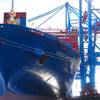US Maritime Industry Working to Solve the People Puzzle
For companies active in all parts of the commercial maritime sector, finding and holding onto the workers they need to build, operate and service the industry’s wide range of vessels has been challenging. Simply put, the labor market is tight, and the problem is not getting any easier to solve.
Mike Ellis, CEO at American Commercial Barge Line (ACBL), said a continued shortage of qualified personnel has been the most pressing issue for ACBL—and probably for the barging industry as a whole. “There's been so much demand on people. It's been harder to get people in the door, harder to choose a career on the water for these young adults coming out of either high school or college. So, we've had to make a lot of changes to our business to attract the people we need to attract.”
The situation is similar in other parts of the industry too, especially as workforce issues stemming from the COVID-19 pandemic are still being felt. Ira Douglas, vice president of labor relations at Crowley, said, “While we and other industry peers are striving to find new ways to attract a diverse workforce, we are not immune to the labor market pressures and the residual impacts of the pandemic.”
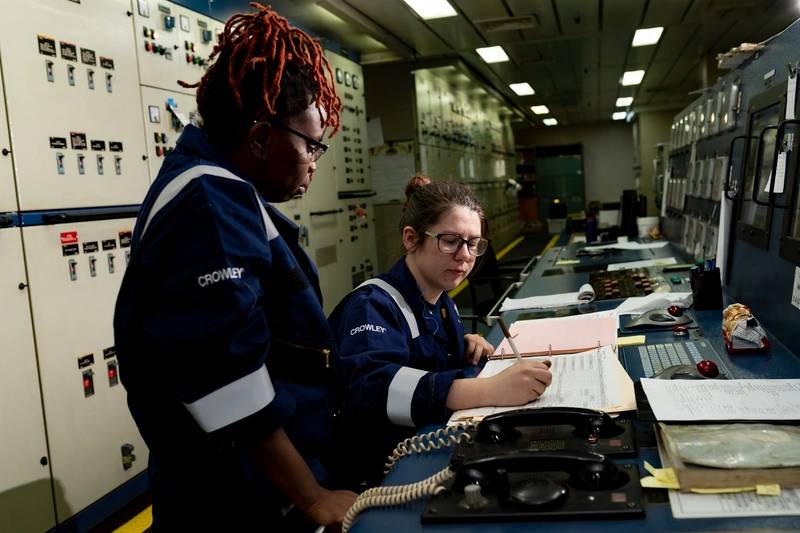 Crowley is currently seeking to hire mariners in various positions, and Douglas said demand is particularly high for able seamen, deck officers and engineering officers. (Photo: Crowley)
Crowley is currently seeking to hire mariners in various positions, and Douglas said demand is particularly high for able seamen, deck officers and engineering officers. (Photo: Crowley)
The same is true in the passenger vessel sector, said Richard J. Paine, Jr., vice president, quality assurance (HSSQE) and proposal management, at the Hornblower Group. “Hornblower is no different than many other companies coming out of the pandemic the last few years. We have been steadily hiring across our business' in the U.S. and on the global level since restarting many of our operations,” he explained. “Within the United States, we are currently looking to fill roughly 500 positions as we gear up for peak season at many of our sites. These positions are not limited to vessel crew alone, but include shore-based and hospitality positions, as well. In our industry, we are always looking for experienced captains.”
Large and small shipyards are also dealing with their own set of workforce woes, with many actively recruiting for a variety of roles. Philly Shipyard said in its recent first quarter financial report that it still experiencing operational disruptions arising from the pandemic and the federal contractor vaccine mandate. “Despite aggressive recruiting efforts, the pandemic and mandate prevented Philly Shipyard from ramping-up its workforce in accordance with plan. COVID driven labor shortages continue to impede Philly Shipyard’s efforts to efficiently maintain its workforce.”
With labor markets tight, Julie Blount, executive vice president at Blount Boats, said the Warren, R.I. shipbuilder has been “in direct competition” with other shipyards for skilled workers, and that many employers have been “forced to rely more heavily on bringing in subcontractors” in order to keep up with production. As of this writing, Blount was looking to hire at least five first class aluminum welders.
Contributing to the problem, Blount said, is an educational shift that occurred in the U.S. several decades ago. “We now understand the value of trade schools. However, over 20 years ago, local school districts adopted college-prep-for-all and often eliminated vocational education,” she explained. “We are now seeing a renaissance happening in vocational training. High schools are now stepping back in the game, but we lost a few decades in training skilled carpenters, welders, plumbers, electricians for today’s workforce.”
To help ensure it has the skilled workers it needs, Blount Boats has offered apprenticeship programs, weld training and leadership workshops, which have led to opportunities for advancement, Blount said, adding that maintaining a competitive compensation package has also been helpful.
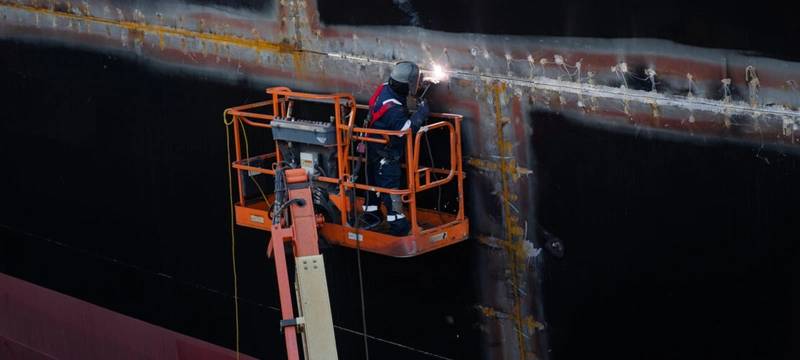 Philly Shipyard said it is experiencing operational disruptions arising from the COVID-19 pandemic and the federal contractor vaccine mandate. (Photo: Philly Shipyard)
Philly Shipyard said it is experiencing operational disruptions arising from the COVID-19 pandemic and the federal contractor vaccine mandate. (Photo: Philly Shipyard)
Frank Manning, vice president of operations and business development at Diversified Marine, Inc., in Portland, Ore. said the local talent pool can only go so far as the shipyard, much like Blount Boats, must compete with other yards in its region. “We’ve had to bring in people from the Gulf; I’d say right now somewhere around 20% of our workforce coming from there, and that fluctuates,” Manning said. “One of the challenges with that is as a lot of those workers are travelers, and they're fine with getting a job here, working for two months and then going somewhere else. It's not necessarily a workforce that you can depend on and grow with.”
Diversified presently has a yard workforce of about 35, with current openings in all trades, Manning said. “We're hiring structural welders, fitters, pipe welders, fitters, painters, joiners, fabricators, riggers and laborers.”
In the U.S., it is frequently said that the maritime industry is often “out of sight and out of mind” for most people, and this only adds to the hiring problem. Many simply aren’t aware of the industry and the job opportunities that are available.
“As an industry as a whole, we need to do a better job of showing what we do and making it exciting and attractive to the next generation,” Manning said, noting that the shipyard workforce is aging. “If we don't get ahead of that and show the next generation that this is a good industry, and one that you can build a career in and that your work actually matters, we're going to be in trouble.”
Manning said Diversified Marine recently hired a marketing firm to come in and shoot targeted ads for recruitment on widely used social media platforms such as Facebook and Instagram. “We're getting a good response on that,” Manning said. “We're putting the idea in front of people.”
“Those in the industry that figure out the next generation are going to be the ones that win. And the only way to do that is by showing people that it's out there and that it's cool,” Manning said.
Hornblower, too, is expanding its outreach to grow its workforce. “We continue to explore and introduce new recruitment efforts to bring the most qualified candidates into the businesses.” Paine said. “We have introduced new expansive hiring outreach campaigns in addition to our proven traditional avenues, such as job fairs, career days, online tools and social media to attract new employees to the company, and in some cases, to the maritime industry. We believe in creating amazing experiences and that starts with our exceptional crew and employees. We offer competitive pay, a wide range of benefit options and flexible work schedules to attract quality candidates.”
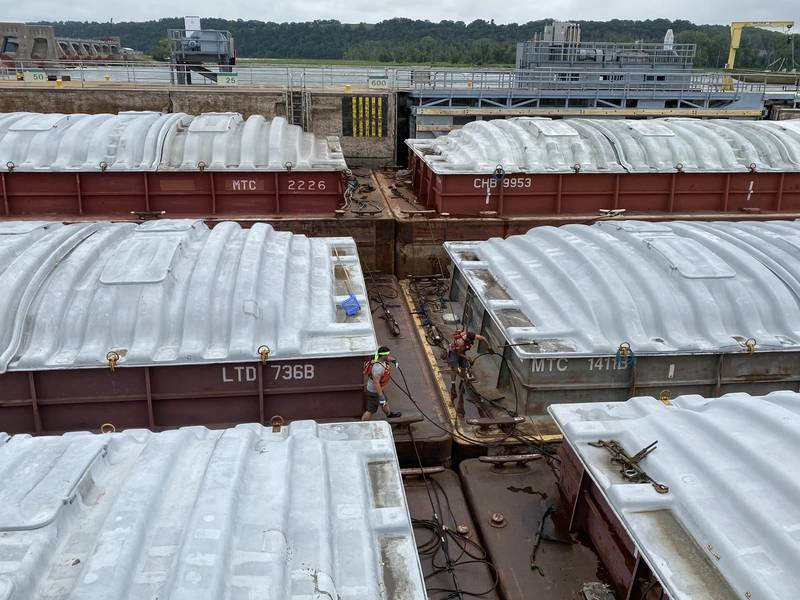 Attracting younger generations to work in the maritime industry will be key to its future success. (Photo: Eric Haun)
Attracting younger generations to work in the maritime industry will be key to its future success. (Photo: Eric Haun)
A challenge the industry faces is that the work is both physically and mentally demanding in nature, which can be a turn-off for some. That is to say companies need to find and retain the right type of people. “We have to run the business safely, and we have to have qualified people that are willing to make a career in this business. But 28 days on and 28 days off—that's probably our most popular schedule—it's not for everyone,” ACBL’s Ellis said. “We can't pay our way and hire our way out of this. We have to train our way out of this. We have to invest in the future of our people, by continuing to train and keep a pipeline of qualified mariners ready to step up to that next position when we have either a retirement or someone leaving the industry for some other reason. That is something our industry works on as a whole, and we spend a lot of time working at ACBL to make it the most attractive place for mariners who want to start a career.”
Ellis said ACBL has seen its flow of applicants grow after the company expanded its search efforts beyond the areas it has traditionally pulled talent from, tapping into areas hit by slowdowns in other industries. “We've had to go out and find those applicants. It didn't just happen,” Ellis said. “It's been a team effort to go to those communities where we could be most effective.”
ACBL has also had great success through in-company mentorships for its new hires, with the aim to help the next generation meet their goals and advance their careers. “We've made sure that their mentors are keeping contact with them even during the periods when they're not on the boat,” Ellis said. “We like to say the biggest asset someone has to invest is their time, and we're very cognizant of the fact that their investment needs to pay returns. We are doing more to fulfill their mentorship, help them advance faster. The faster you advance, the more money you make, obviously, but also the quicker you can get to the position that's your goal, whether it's in the wheelhouse or the port captain, come onshore. There's a lot of different opportunities, and having that mentor and that career path are important. And we find that as we've been more proactive in that effort, our retention rates have gone up.”
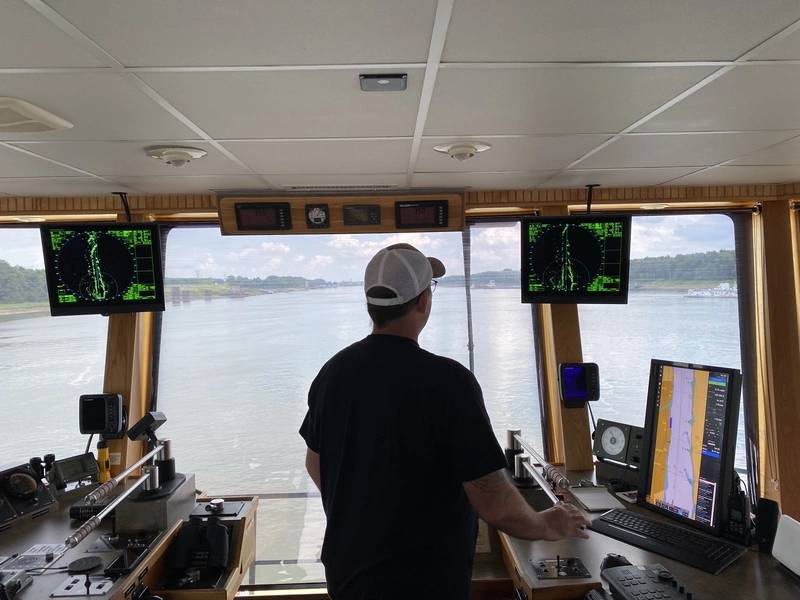 It’s a difficult process to advance to the wheelhouse, but ACBL offers program and incentives to help its mariners work their way up to steersman. (Photo: Eric Haun)
It’s a difficult process to advance to the wheelhouse, but ACBL offers program and incentives to help its mariners work their way up to steersman. (Photo: Eric Haun)
Similarly, Paine said that Hornblower has long been committed to developing its workforce from within. “For over 35 years, we've believed that ensuring we have skilled and dedicated workers starts with our emphasis on training programs and offering avenues for career advancement. In addition to our existing workforce, we thankfully have a mix of excellent employee referrals, multi-generational family members and excited new employees who start their career with Hornblower throughout our American Queen Voyages, CityCruises, CityFerry, CityExperiences & Journey Beyond businesses.”
Paine added that Hornblower’s size creates a wider range of workforce opportunities “from coast-to-coast and everywhere in between”, as well as in various marine roles in Australia, Canada and the United Kingdom in addition to other hospitality and experience-based offerings around the world. “Our crew can stay within the company while pursuing new opportunities and licensing advancements throughout our family of companies,” he said. “Not many companies can offer what Hornblower can, by having an employee start as a deckhand in California, follow an opportunity to become a 100 GT captain in New York City and then pursue larger licenses in our other businesses around the globe. It is pretty exciting and rare to be able to offer that type of career longevity, flexibility and advancement.”
Douglas said reaching the next generation is one of the main priorities for Crowley as it works to address the deficit within the maritime workforce, and that collaboration with other industry stakeholders has been crucial. “We collaborate with maritime academies and other educational institutions to attract and support our next generation of mariners,” Douglas said. “Our teams regularly attend conferences, career fairs and other industry-focused events to reach potential candidates for the industry. We offer the largest number of sea-term opportunities in the domestic industry for cadet training aboard our vessels and internships programs to increase interest and provide a hands-on perspective of various roles within maritime.
“Equally as important, we are collaborating with our labor partners to develop the talent pipeline, including ensuring training, technology and development opportunities for existing mariners are available. We’re working hard to emphasize the benefits of a maritime career—which is virtually like no other in what they can see and enjoy.”
Crowley also strives to make its working environment attractive to both prospective and current employees. “Crowley is consistently evaluating and elevating the quality of life for our mariners while aboard our vessels as well as while they are shoreside. This includes everything from reconfiguring recreational space and amenities, shipboard connectivity, and physical and mental health resources and making the experience as safe and dependable as possible for any woman or man,” Douglas said.
Another company taking steps to attract the next generation of skilled shipyard workers is St. Johns Ship Building (SJSB). The Palatka, Fla. shipbuilder—which builds and repairs a number of vessel types, including crew transfer vessels (CTVs) for the United States’ growing offshore wind industry—recently introduced a vocational training program “designed to cultivate a variety of sought-after marine and shipbuilding crafts and trades”. It said the program will combine both classroom instruction and hands-on experience via multi-year, on-the-job apprenticeships, offering paid opportunities for candidates throughout its duration.
Ed Sheets, executive vice president of SJSB’s parent company, Americraft Marine Group, said in a statement, “We hope that St. John's can play a crucial role in introducing shipbuilding crafts to hundreds of qualified candidates in the coming years. Expanding our workforce is not only vital for the long-term success of our industry but also provides SJSB with the unique advantage of training future employees on our own campus. This enables them to align their skill development with the adoption of the culture and values we believe are essential for a high-performing team.”
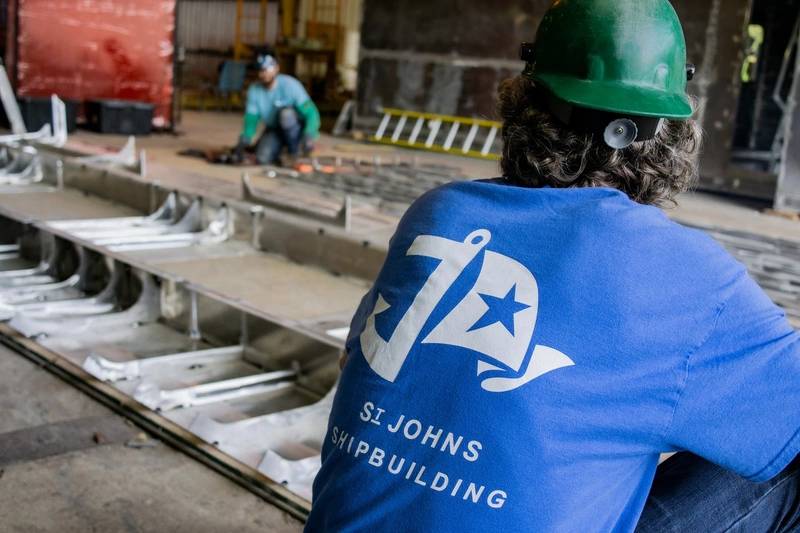 St. Johns Ship Building launched a new vocational training and apprenticeship program (Photo: St. Johns Ship Building)
St. Johns Ship Building launched a new vocational training and apprenticeship program (Photo: St. Johns Ship Building)
Crowley is another company leading the way to help grow the United States’ offshore wind industry. “Knowing that [this] sector will need significant levels of maritime workers, we are initiating programs on both coasts to support education and training opportunities – even at the high school level,” Douglas said. “We are working with academies and colleges to create training programs and curriculum to support the U.S. wind industry. For example, Crowley has partnered with Massachusetts Maritime Academy to create a first-of-its-kind training and workforce development program to advance the U.S. offshore wind workforce.”





